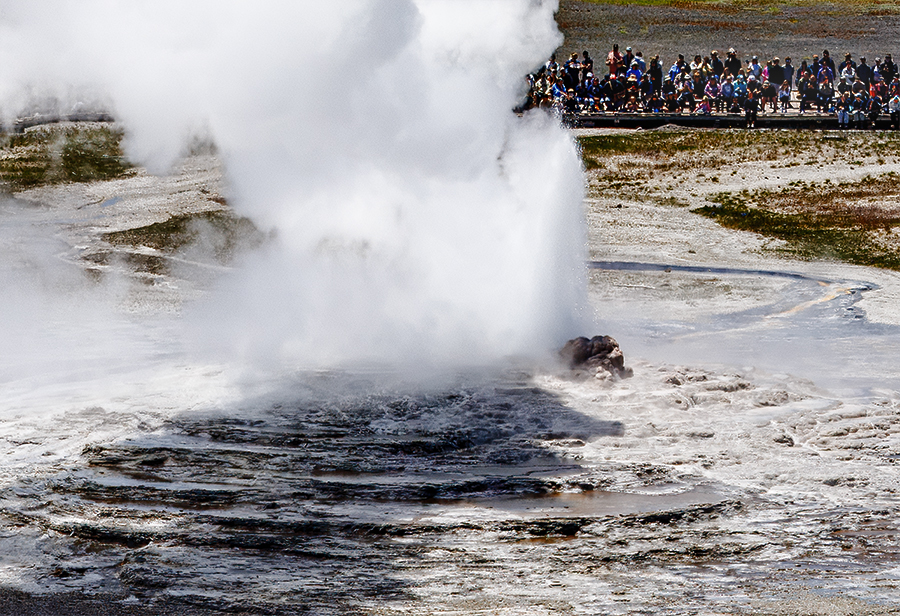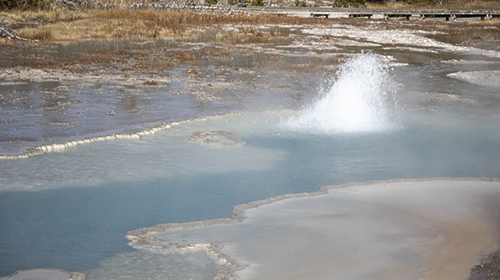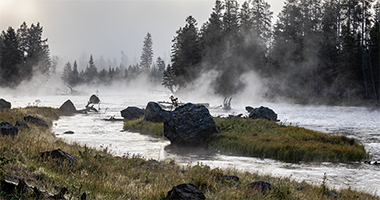Predicting Yellowstone's Old Faithful Geyser

One question that Rangers working in the Upper Geyser Basin get frequently is this. "How do you predict Old Faithful?” I want to teach you how you can predict Old Faithful Geyser. I hope this becomes a fun activity for you, your children, students, or family.
You may find it beneficial to watch the Predicting Old Faithful Geyser video here. It is not required because the steps are listed here. But it does give the rest of the story of what rangers do while making predictions.
To time Old Faithful Geyser, you need the following tools.
- Internet access
- Paper and pen/pencil, or print out the following instructions from here.
- Stopwatch
- Clock


Before doing the exercise, you will need the prediction time.
I need to provide these warnings. Geyser predictions will only be made when Rangers are on duty. The Visitor Center is also closed when the roads are closed, meaning no predictions. These periods are mid-March to mid-April and mid-November to mid-December.
Instead, you must watch the webcam until you see preplay water splashes.
The times shown are in Mountain Time, and you must adjust your thinking accordingly. If you are on the East Coast and the geyser prediction is 1:37 pm, you must watch for it at 3:37 pm.
You will need to access Old Faithful’s webcam to do this exercise. The webcam is up on the roof of the Old Faithful Inn. Unfortunately, it goes down on occasion. Due to weather, staffing, or other issues, it can take hours or days to get it up and running again. So, if the webcam isn’t working, try again later.
Making the Prediction
The steps for predicting Old Faithful Geyser are as follows:
- Locate the prediction for the next eruption from either of these methods:
- Call the Geyser Prediction Line at 307-344-2751 and press option 1.
- Go to Current Geyser Activity - Yellowstone National Park (U.S. National Park Service) and scroll to the Latest Geyser Eruption Predictions section below the film.
- Use the official NPS app. Access Yellowstone National Park and then select Geyser Predictions on the right side of the screen.
- Use the Geyser Times database. Click on the words Old Faithful on the list. Check the prediction time on the left side of the screen. If there are two prediction times, use the NPS listing.
- Take a piece of paper and write the following across the sheet, or use the printed instruction form above:
- Predicted time
- Preplay: The first time you see water splash out of the geyser vent.
- Start: The time that the preplay splash that turned into the eruption started.
- Duration: The length of the eruption. Starting when the preplay splash turned into the eruption until the last water you can see.
- Enter the predicted time in the Predicted Time column.
- Open the Old Faithful webcam located here.
- Enlarge the video and press the play button.
- Start watching Old Faithful Geyser 10-15 minutes before the predicted eruption.
- When you see the first sign of a water splash, check the time and start the stopwatch.
- Document the start time of the first preplay splash under the Preplay column.
- Stop and reset the stopwatch when the water stops.
- Repeat steps 7 and 8 until one of the splashes turns into the eruption. You only have to document the preplay splash with the first one and the one that turns into an eruption. Once Old Faithful turns a preplay splash into an eruption, leave the stopwatch running until you see the last drop of water. Stop the watch when the water has stopped. The time on the watch is the duration of the eruption.
- Enter the time on the watch under the Duration column on your page.
- Use the table below to start your calculations for the next prediction time. You will make the prediction based on 20- second intervals. So, If the duration is 3:41 minutes, the prediction will be different than a duration of 4:10 minutes.
- Look at the documentation you did for the eruption.
- Take the duration and look at the chart below. Find the correct duration time.
- Add the number of minutes for the interval time to your documented start time.
- Example: Say the eruption started at 3:14 pm and lasted 3:55 minutes. I would need to add 100 minutes to 3:14 pm, so my next prediction is 4:54 pm.
- After you have created your prediction, check yours against the Rangers’ next prediction. See step 1 above.
- How close were you?
- If you were off by a lot, it can be one of several things:
- Your math is off, or the Rangers’ math is; it happens occasionally.
- You started your stopwatch late or stopped it too soon.
- The rangers have changed the prediction intervals as new data develops.
- To check your accuracy, watch the next eruption and see how close you are. Remember, Old Faithful has a window that runs from ten minutes before until 10 minutes after the prediction. Say your prediction is for 10:15 am. The window runs from 10:05 am to 10:25 am. If your prediction time is within that 10:05 to 10:25 am window, your prediction time is valid. If Old Faithful had erupted outside your prediction window, you could have added it correctly, but Old Faithful Geyser decided to do its own thing and erupt early or late.

| Duration of this eruption | Interval to use (noted in minutes) |
|---|---|
| 1:00 – 1:19 | 61 |
| 1:20 – 1:39 | 66 |
| 1:40 – 1:59 | 68 |
| 2:00 – 2:19 | 71 |
| 2:20 – 2:39 | 75 |
| 2:40 –2:59 | 80 |
| 3:00 – 3:19 | 90 |
| 3:20 – 3:39 | 98 |
| 3:40 –3:59 | 100 |
| 4:00 – 4:19 | 102 |
| 4:20 – 4:39 | 104 |















